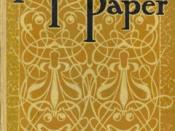ÃÂShe has so long been subject to the disabilities and restrictions, with which her progress has been embarrassed that she has become enervated, her mind to some extent paralyzed; and, like those still more degraded by personal bondage, she hugs she chains. Liberty is often presented in its true light, but it is liberty for man.ÃÂ-Lucretia Mott Speech ÃÂDiscourse on WomenÃÂ. The late 19th century was an era dominated by man where women were held hostage under the confinements of society. However, it also marked a time where women were crossing a threshold of freedom led by those such as Lucretia Mott. Charlotte Perkins GilmanÃÂs short story ÃÂThe Yellow WallpaperÃÂ is symbolic of this era as it testifies the struggles of women under the strict authority of men. The story is told first person through the narrator who descends into madness as she undergoes ÃÂthe rest treatmentÃÂ (a treatment prescribed for nervous disorders at the time) under strict supervision enforced by her husband.
Through the power of language and intellectual vigor, Gilman shows that society can force people into unwanted roles and that lack of intellectual stimulation and self expression can lead to insanity.
In ÃÂThe Yellow WallpaperÃÂ many aspects of symbolism are used to let the story take on more that itÃÂs obvious meaning. John, the narratorÃÂs husband symbolizes a society base ton the domineering race of man. He a ÃÂphysician of high standingÃÂ(331) assumes the right to control his wife, leaving her to be treated as a child, dependent and incapable. The narrator is told that she is to take ÃÂphosphates or phosphites- whichever it is, and tonics, and journeys, and air, and exercise, and [is] absolutely forbidden to work until [she] [is] well againÃÂ(332). Despite recognizing her husbandÃÂs sincere efforts she says,


